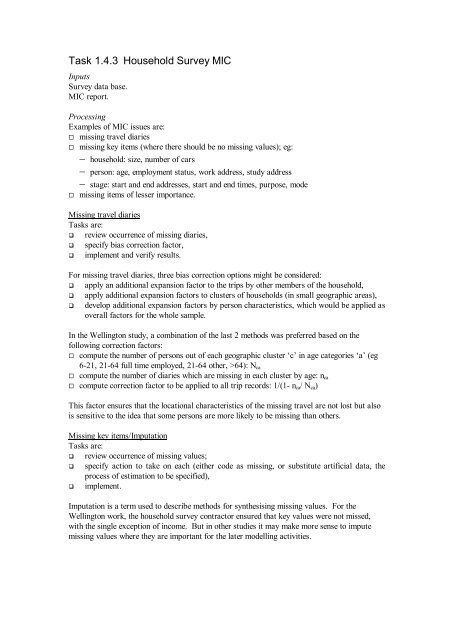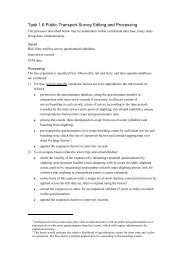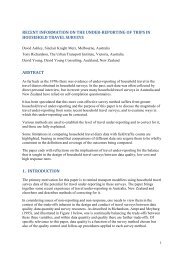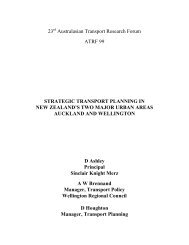MIC - Transport Modelling Templates by David Ashley
MIC - Transport Modelling Templates by David Ashley
MIC - Transport Modelling Templates by David Ashley
Create successful ePaper yourself
Turn your PDF publications into a flip-book with our unique Google optimized e-Paper software.
Task 1.4.3 Household Survey <strong>MIC</strong><br />
Inputs<br />
Survey data base.<br />
<strong>MIC</strong> report.<br />
Processing<br />
Examples of <strong>MIC</strong> issues are:<br />
missing travel diaries<br />
missing key items (where there should be no missing values); eg:<br />
household: size, number of cars<br />
person: age, employment status, work address, study address<br />
stage: start and end addresses, start and end times, purpose, mode<br />
missing items of lesser importance.<br />
Missing travel diaries<br />
Tasks are:<br />
review occurrence of missing diaries,<br />
specify bias correction factor,<br />
implement and verify results.<br />
For missing travel diaries, three bias correction options might be considered:<br />
apply an additional expansion factor to the trips <strong>by</strong> other members of the household,<br />
apply additional expansion factors to clusters of households (in small geographic areas),<br />
develop additional expansion factors <strong>by</strong> person characteristics, which would be applied as<br />
overall factors for the whole sample.<br />
In the Wellington study, a combination of the last 2 methods was preferred based on the<br />
following correction factors:<br />
compute the number of persons out of each geographic cluster ‘c’ in age categories ‘a’ (eg<br />
6-21, 21-64 full time employed, 21-64 other, >64): N ca<br />
compute the number of diaries which are missing in each cluster <strong>by</strong> age: n ca<br />
compute correction factor to be applied to all trip records: 1/(1- n ca / N ca )<br />
This factor ensures that the locational characteristics of the missing travel are not lost but also<br />
is sensitive to the idea that some persons are more likely to be missing than others.<br />
Missing key items/Imputation<br />
Tasks are:<br />
review occurrence of missing values;<br />
specify action to take on each (either code as missing, or substitute artificial data, the<br />
process of estimation to be specified),<br />
implement.<br />
Imputation is a term used to describe methods for synthesising missing values. For the<br />
Wellington work, the household survey contractor ensured that key values were not missed,<br />
with the single exception of income. But in other studies it may make more sense to impute<br />
missing values where they are important for the later modelling activities.
The literature (particularly work <strong>by</strong> Tony Richardson) offers many imputation techniques. In<br />
Wellington, personal income was imputed as follows: persons who did not report their income<br />
were allocated randomly the income of someone else in the household sample who had the same<br />
characteristics in regard to:<br />
home location,<br />
age (15-20, 21-30, 31- 40, 41-65, 65+),<br />
occupation, and<br />
employment status - full-time, part-time, retired.<br />
Outputs<br />
Trip Correction Factors in the data base.<br />
Synthesised values for some questions in data base (it is wise also to include a ‘flag’ in the data<br />
base identifying synthesised values, enabling them to be excluding from analyses if required).<br />
Note.





